

JAWS
What I've learned from growing dozens of Venus Fly Traps.
Growing Venus Fly Traps to see how large a trap you can grow is a fascinating hobby, but it has its hazards:

Every adult remembers the wonder when, as a child, they first learned about Venus Fly Trap plants and their ability to snap shut and devour insects. Watching 1950s horror movies in my youth like Voodoo Island, with plants that could swallow a child, primed me to be fascinated with flytraps. After many years I decided to take a closer look at these little gems of the botanical world. This page is a record of what I learned from on-line research and hands-on experience.

My first Venus Flytrap in many years. It measured about 3 inches
in diameter and had traps 7/8ths of an inch long. It cost $5.00
at Walmart in the Fall of 2005. This image shows it full size.
After purchasing my Fly Trap I spent considerable time reading about them on dozens of different websites. What follows is a condensation of everything I learned:
General Description:
Venus Fly Traps, Dionaea Muscipula, are unique in the plant world in that they consist of only one species (they're monotypic), although plant breeders have developed several cultivars from nursery-grown stock, some of which have redder traps and leaves and vary slightly in size. Traps on some of these have been claimed to be as large as 5 cm (2 inches) long. Mutations have also been developed with non-closing traps that look like pompons, some that have saw-toothed edges, and other variations. The varieties consistently mentioned as having the largest traps are Fang, Big Vigorous and Big Mouth.
Fly Traps evolved in bogs in North and South Carolina within a small area 100 miles in radius. Wild Venus Fly Traps are an endangered species because of collectors. Fly Traps purchased in stores have all been grown in nurseries.
The name "Venus" was applied to the plants by Arthur Dobbs (1689-1765), a puritan botanist. It is unclear if this was in reference to the plant's ability to trap, or ensnare, insects as the goddess Venus empowered women the ability to ensnare men, or because some people claim the traps resemble certain aspects of female anatomy.
The Plants developed their ability to trap insects because the boggy soils in which they evolved were too poor in nutrients to support growth. Their natural environment consists of moist, acidic soil of little or no fertility, bright but not direct sunlight, high humidity, warm temperatures in summer and cool in winter. Fly Traps are classes as half-hardy, meaning that they can survive brief, mild frosts. They grow from rhizomes, a fleshy underground stem. In Spring they produce a tall (12-inch) flower stalk with white flowers and then set seed. They can also reproduce by the rhizome growing and splitting. One reference stated that Venus Fly Traps have a maximum of 7 leaves. If a plant has more than this it's supposed to indicate that the rhizome has split and the plant is actually two or more plants.
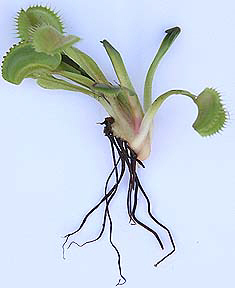
As this photo shows, the root system is extremely small. This
makes sense because all it has to do is provide a mechanical
anchor and a little water to the plant. This small plant had ten
leaves so according to the last reference its rhizome should have
split. However, I don't see any indication of this. The rhizome is
the white fleshy mass out of which the leaves are growing.
Fly Traps are adapted to four seasons and their growth pattern varies accordingly. In Spring the leaves and traps are short and fat and tend to lay close to the ground. In summer a new set of longer, thinner leaves appear and are held higher in the air. In Fall the leaves and traps again get smaller and closer to the ground.

This flytrap is entering it's dormant phase in late Fall.
Note the long, narrow summer leaves indicated by the
black arrows and the much shorter, fatter leaves on the
rest of the plant, typical of Fall and Spring growth.
In winter the plant can go dormant, partially or completely dying back to the ground in areas where the weather drops below freezing on a regular basis.
They attract insects to the traps with perfume secreted by the traps and in most cases the red coloration of the inside if the traps. Each trap has six trigger hairs. When two are touched, or one twice, in close succession the trap closes in approximately one-half of a second. The action isn't so much of a "snapping" but an "easing" closed. The velocity of the closure decreases considerably towards the end of the motion.
Trapped insects are digested by fluids secreted around them by the trap once it's tightly sealed. The traps also secrete an antiseptic to prevent the insect from rotting before it can be digested. Depending on the insect's size and hardness of the it's outer body, digestion can take anywhere from 5 to 12 days. At that time the trap slowly reopens over a period of 1 to 3 days and the dried remnants of the insect blow away. A single trap can trap an insect three or four times before dying, turning black, and falling off.
The traps and foliage have a thick, leathery feel. Large single plants are at best still small: 6-8 inches across.
Digesting a Fly:

A closed trap. The edges are sealed tightly and the trapped
fly is digested in the the pocket near the trap's hinge.
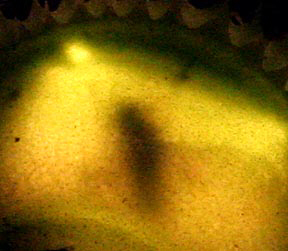
This image was taken immediately after the trap
closed by shining a bright flashlight through the trap.
The fly's head is up and the outline of one wing
extending to the right is barely visible.
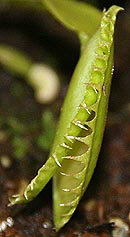
Four days later the trap began opening by peeling apart from the far end.
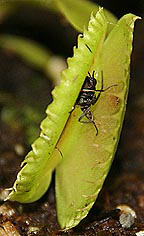
Twelve hours later the trap had opened enough to show the dried husk of the fly.
The large amount of residue suggests that flies have a high waste-to-food ratio
and as such may not be the best food for Venus Fly Traps.
Theories About How the Traps Close:
I was surprised to discover many theories about how the traps functions. In the absence of of a consensus supporting one theory I decide to list them all.
1. Two references stated that no one knew how the traps worked. This absence of a theory supports the concept that the process could still be a complete mystery.
2. Two other references claimed that the driving mechanism is fluid pressure. Triggering the trigger hairs releases the pressure driving the trap closed.
3. One reference claimed that when activated the trigger hairs cause an almost instantaneous burst of growth of the cells of the outside surface of the trap of 25 percent. This is achieved by something referred to as acid growth. A special acid is released into the cells which temporarily softens the fibers of the cell walls and allows them to expand very quickly. After the insect is digested, the inside of the trap grows an equal amount reopening the trap. If this is correct then a trap should increase its size by 25 percent every time it's activated.
4. The final theory I came across argued that the traps grow like one-half of a tennis ball that's been stretched inside out. In both cases mechanical stresses are built up in the fibers of each structure which, when triggered, causes each to revert to the unstressed state. In the case of the half tennis ball it snaps back to its original shape with the fuzzy side out. In the case of the Fly Trap, the trap closes. One observation that seems to support this theory is that traps are convex when open and concave immediately after being triggered. After digesting the insect the trap goes through a growth period that opens the trap, recocking it for the next unwary fly.
In an attempt to determine if the traps are closed because the outside grows or if cells are just temporarily inflated, I marked a trap with three white dots and measured their separations.

I then triggered the trap and remeasured the spacings. The dots had increased their separations by 10-percent. Then I measured the separation again after the trap had reopened and discovered that The 10-percent increase had remained. What this suggests is that it is a growth phenomenon, not a simple inflation of the outer cells that drives the closure. If it were inflation, then the cells would shrink back to their original size when the trap reopened.
NEW!!! For an outstanding explaination of trap closure physics, I highly recommend visiting http://www.sarracenia.com/faq/faq2800.html.
Culture:
Venus Fly Traps have to be grown under conditions that mimic the environment for which they evolved: moist, acidic bogs. This is most easily achieved by using a soilless mixture of peat moss and either perlite or sand. Because Fly Traps can be sensitive to salts, sand can be more problematic that perlite since sand many times contains both salts and various chemicals. The usual mixture is 75 percent peat and 25 percent perlite. All of the references claimed success with either this mixture or slight variations of it. One claimed that the best mixture was simply 100 percent peat moss. Another preferred African violet mixes. Many sources prefer peat moss and silica sand, stating that the sand can be as high as 60 percent. However, it must be clean and not beach, construction, or white sand as these may have salts or minerals in them. The important thing is to have a very acidic base (PH = 3 to 5.) Two sources also suggested including 10 percent activated charcoal. This wide range of soil recommended soil types suggests that Venus Fly Trap plants are actually quite forgiving as far as what medium they grow in.
This mixture should be kept constantly damp, but not saturated. Virtually all the references suggested achieving this by placing the pot in a saucer with 1 inch of water and allowing capillary action to carry water up to the root zone. One nice thing about the saucer of water technique is that it provides additional humidity in the immediate vicinity of the plant. (Note: Peat can hold so much water that a good soaking once every few days might work as well.) The humidity issue may not be critical. I found two references that stated that anything around 50 percent is fine and they may even do well at lower levels. (Mine seemed to do fine around 20-percent.) UPDATE! More recent cultural recommendations state that the saucer watering technique keeps the soil so moist that root rot invariably kills the plant. My own experiences support this. As of 2015 the preferred method of watering is to water from the bottom thoroughly, then drain and not water again until the top surface of the peat has dried. In winter this may take over a month. In hot, dry locations weekly waterings may be required.
Many of the references also recommended growing Venus Fly Traps in terrariums, though if placed in a sunny location the enclosure might cause temperatures to rise dangerously high. Also, feeding and rot can become problems.
All of the sources recommended using distilled water to avoid the buildup of minerals and salts that could injure the plant's roots. For this same reason they all recommended not adding even the weakest fertilizer to the water or soil, claiming it could kill the plant. One reference did say that if you wanted to fertilize a plant you could do so by dipping a Q-tip in orchid fertilizer and rubbing it on the underside of no more than three leaves. The goal is to avoid letting any of the fertilizer drip onto the soil either from the Q-tip or from drops sliding down the leaf. This was only recommended in place of feeding the plant insects.
Large commercial growers are forced to use fertilizers because it is impractical to catch thousands of insects everyday to feed greenhouses full of plants. What one source stated doing was to use water soluble fertilizers mixed at 1/10th strength and fed to the plants every 2 to 4 weeks.
The best insects to feed the plant are those with soft bodies that are 1/3 to 1/2 the size of the traps. The hard shells of beetles and similar insects make them difficult to digest. One reference stated that after starving a plant for one year, it was then fed an insect in each trap. The result was that all the traps died and it set the plant back two months. This suggests that the plants can be over fed. (The likely cause was that the stress of trying to produce so much digestive fluid at one time weakened the plant.) On the other hand the problem may have been caused by the year of non-feeding weakening the plant. Most references state that 3 to 4 insects a month is enough. Several sites warned against trying to feed a Fly Trap hamburger; the fat content could injure the plant. Over feeding may lead to reduced trap size and long, weak growth.
Trap closure goes through two steps: immediate rough closure and the tightening/sealing closure. The first is the one we see. The edges of the trap remain slightly open to let very small insects escape (they'd have too little food value to make up for the energy invested by the plant to digest them.) If the insect is large enough to be trapped, its movements in trying to escape triggers the second tightening/sealing phase where the trap presses together to form a watertight seal around the insect. If the trap is fed a dead insect, it's necessary to gently massage the trap several times to simulate the insect trying to escape and trigger the sealing phase. Otherwise the trap will just reopen or worse, begin to rot as the insect inside putrefies.
All the references recommended removing blackened traps and leaves as soon as they form. This rotting away of used traps and leaves is normal. They also recommended avoiding triggering the traps to close as entertainment. Repeatedly doing so weakens the plant.
A 4 inch plastic or glazed ceramic pot is a good size for one plant. Non-porous materials are preferred over porous ones like clay because they don't lose as much moister to evaporation through the sides. One reference stated that Fly Trap roots can get quite long while another claimed they only get a few inches long. More recent studies have verified that Venus Fly Trap roots can grow up to seven inches long. As of 2015 more and more growers are recommending individual plants be grow in small tree seedling pots, which are 4 x 4 x 9 inches, though 5 x 5 x 6 inch pots do well and are more readily available.
The plant should receive 3-6 hours of bright sunlight a day. Again, be careful of direct sunlight if the plant is in an enclosure like a terrarium because temperatures can get high enough to cook the plant. If Fly Traps are grow under fluorescent lights, they should be 4-7 inches above the plant and left on for 12-16 hours a day during the summer growth period. Ten to 12 hours a day for Spring and 8-10 hours for Fall should help the plant stay on track with its natural cycle and encourage it to go dormant in winter.
One reference stated that plants grown year-round under fluorescent lamps run out of steam after two or three years and die. This suggests that the plants need a dormant period of 3 to 4 months every year to stay healthy. The typical period of dormancy is from Thanksgiving to Valentine's day.
Three references stated that the plants should be repotted every second or third year. The reason is that the peat slowly breaks down and becomes so compacted than air can't reach the roots. The best time for repotting is in the winter while the plant is dormant.
Winter storage can be tricky. Some references state that it's best to lift and wash the rhizome, spray it with a fungicide (some claim cinnamon works), wrap it clean damp peat in a plastic bag and store in a refrigerator. Others claim it's better to leave the plant in the soil, still bagging it and placing it in the frig. Still other state it's best to leave the plant alone and let the natural conditions it's in determine its level of dormancy. All sources recommend giving the plant complete darkness and that watering should be reduced so that the soil is kept barely damp. UPDATE! As of 2015 the recommended method of over wintering is to reduce the temperature, water, light duration and intensity (slightly) to trigger dormancy but otherwise keep the plant growing and continue feeding the plant.
One reference stated that Venus Fly Traps grow their largest and healthiest outside against an east-facing wall where they get morning sun. This assumes that their particular soil and moisture requirements have been satisfied. Aphids can attack and damage Fly Traps so the plants need to be checked regularly. Another reference claimed that they should never be stored in dim light during their dormant period because this will cause them to continue to try and grow, but with too little light they will only use up their energy reserves and may die. I do not know how they would do outside in more temperate climates like the south west of the USA.
Spring flowering eats up a lot of the plant's energy and may stunt or slow its growth for the rest of the year. Clipping the flower stalk off as soon as practical might encourage plants to grow larger and healthier. On the other hand, letting the flowers produce seeds and then planting the seeds might result in a new and interesting cultivar.
Some plants are forced into summer dormancy so they are fresh for the Fall market. In such cases the plant's sense of timing has been knocked out of synch with the natural seasons and it may take a year for it to get back to normal growth patterns.
One reference claimed that plants grown in bright light tend to produce smaller leaves and larger traps.
Two references stated that properly cared for Venus Fly Trap plants may live from 10 to 20 years.
Propagation
Venus Fly Traps can be propagated through four techniques: division, leaf cuttings, by seed, and through tissue culture.
Division: As a Fly Trap grows, rather than the plant growing as a single large entity the rhizome splits to produce several independent plants. This makes good survival sense because if it remained one plant a severe injury could kill it. But, the odds are that the same injury to a clump of independent plants would leave at least one of them alive. Large Fly Trap rhizomes can be divided in winter when they are dormant by gently pulling them apart. Each can then be planted and will grow into a mature plant by the end of the year. This is the fastest way to grow a new plant.
Leaf Cuttings: Pulling downward on a new leaf in Spring so that it peels off with a small part of the white rhizome attached creates a leaf cutting that can be planted. Providing shaded light, high humidity (cover with a clear dome), and the proper soil moisture will keep the leaf alive long enough to root and grow into a new plant. It takes two years to get a full sized plant from this technique. (I don't know if applying a rooting hormone would help or hurt.) One reference stated that the original leaf will die and turn black about the time the new plant becomes visible.
Seed: Large healthy Fly Traps produce flower stalks in Spring. Left to flower, the plants will produce seed pods which, after several months, will mature and release shiny, black, pear-shaped seeds. Planted, these will germinate in 1-2 months and grow into full sized plants in 3 to 5 years.
Tissue Culture: This is the high-tech technique used by nurseries across the world to produce millions of Venus Fly Traps every year. Plant leaves are cut up into small segments and planted into sterile agar growing medium. Provided highly optimized and controlled moisture, temperature and lighting, each piece will eventually grow into a clone of the parent plant.
Small plants must be fed small food or the trap won't be able to close properly and will rot. The smallest insects easily found are gnats (commonly visibly swarming over lawns at sunset) and fruit flies (usually found in trash containers with rotting fruit. Small ants may also be used. Regular flies, for larger traps, are easiest to capture in the early morning when the cold air slows them down. Although tradition states that sugar or honey is good to attract them, what they actually prefer is a warm compost pile. A pile a rotting grass clipping will draw them like... well, flies. Lady bug larva are also a good mid-size food. Look for them anywhere you find large infestations of aphids. The largest traps may be able to accommodate two or three flies if a properly-sized, soft-bodied insect can't be found.
My Experiences:
While Venus fly traps grow best outside in full sun in most of the US (they are frost hardy but require freeze protection in the north) I decided that I'd grow mine inside under fluorescent lamps so they could be kept at eye-level in a convenient location. Here's a picture of the growing box built for them on a shelf in the garage:
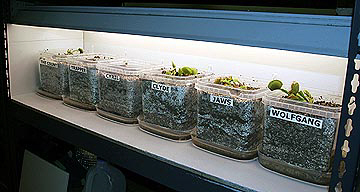
Each plant is in a 6x6x6-inch Tupperware container filled with a fifty-fifty mix of peat moss and vermiculite. The containers sit in trays that hold an inch of water. (This has been changed to the occassional bottom-watering technique and I've greatly reduced the number of lost plants.) (For details about using artificial lighting for growing plants, please see my FLUORESCENT PLANT LIGHTING page.) I currently have seven plants, six of which are show.
From right to left:
Wolfgang: An extra large Big Vigorous plant from the Carnivorous Plant Nursery (http://www.carnivorousplantnursery.com)
Jaws: An extra large Big Mouth plant from the same source
Clyde: An extra large Fang plant from the same source
Cyril: A small Low Giant plant from the same source
Trapper: A medium Czech Giant from the same source
The Count: A large Dutch plant from the same source
Chomper: A normal variety from Walmart (Not shown in the picture)
I purchase all of my high-end plants from the Carnivorous Plant Nursery because this outstanding site offered the widest selection of plant types and sizes at the best prices. The plants were shipped and arrived when promised and were in perfect condition. Michael Szesze, who runs the nursery, was also extremely responsive in answering my email questions and even sent me a free plant with my order of 5 plants. I couldn't have been more satisfied. As an example of the quality of plants offered, consider the following photo of a Fly Trap purchased at Walmart for $5.00:

I purchased it right after the plants were put on display and was able to pick through several dozen to get the very best and largest. This picture was taken a month after purchase and has grown considerably.
Now look at what I got from Michael:

Note that in both pictures my palm is the same size proving that they are both to the same scale. This is one of his Big Vigorous plants and the traps are so large it's scary to put your hand near one. In my opinion Michael's plants are well worth their purchase price. (The plant shown is an extra large size. Medium-sized plants are about the same size as Walmart plants and large plants are halfway in between. However, when dealing with living plants there is always considerable variation in size depending on the time of year, available stock and variety.)
Please accept that I'm not dismissing Walmart or other variety stores as good sources of Venus Flytraps. They are cheap and can provide some great plants. For example: take a look at the following trap of one I found at Walmart in the early Spring of 2006:

Unlike most common plants, this one had brilliant red traps lined with intensly green margins. The traps were also quite large, a full inch long at least.
The trick to gettng a good flytrap from local stores is to first ask the garden manager when the shipment will arrive (usually there's two a year: one in Spring and a second in Fall.) Try to be there the same day the shipment is put on display and sort through them, selecting the largest, healthiest, and most interesting plants.
If you do decide to order plants over the Internet, I recommend ordering the very largest plant size available in the variety you want. Doing so will insure your have instant gratification instead of having to wait years for the plant to grow to a respectable size. The following video shows what I learned by purchasing a large number of plants from what I believe may be the three best on-line sources:
(If you wish to read a question-and-answer interview with Mr. Szesze about his nursery and the carnivorous plant growing business, please see my page INTERVIEW WITH A PROFESSIONAL CARNIVOROUS PLANT GROWER.)
IMPORTANT NOTICE!!! There is a lot of confusion about the accuracy of named Venus Fly Trap cultivars and clones. Because many of these plants can be expensive, I highly recommend that anyone interested in purchasing one of them read the article about cultivars versus clones at: http://www.venusflytrap.info/venus-fly-traps-clones-varieties-cultivars/. After doing so, be sure to contact any prospective seller and verify that what you are ordering is a "clone" produced at his or her nusery, not just a cultivar.
Prior to planting them, I cleaned off the packing material and took the following photo of the rhizome:
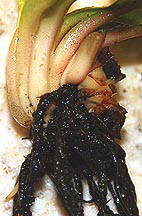
The oldest leaves are at the right of the cluster and the newest are at the left. Note that although the plants may appear to grow in a rosette, in fact they grow in a line. This means that over time the plant will walk forward. If each new leaf extends the rhizome 1/32th of an inch, then over the course of a year the center of the plant may move as much as an inch. Also, the nose of the rhizome seems to be pointing down at a 45-degree angle, suggesting the plant will tend to dig itself deeper over time, perhaps in an effort to get the heart of the plant as deep as possible where it will be better protected from fire and frosts.
Ignoring size and variation in color, all of the traps on the seven different varieties in my collection have the same shape, except Big Mouth. Its traps bow outward noticeably giving them a much greater engulfing volume.
![]()
Typical trap

Big Mouth trap
Trap size is dependent on plant size and maturity so it wouldn't be right to comment on the trap sizes for any except the extra large sizes. The traps on the Big Mouth, Fang and Big Vigorous varieties were all 1 and 5/8ths inches long, considerably longer than the 1 and 1/4-inches advertised on the Carnivorous Plant Nursery site. (Note: a trap size's appearance goes by the square of the length, not linearly with it. Consequently and 2-inch trap will appear to be 4 times as large as a 1-inch trap.)
NEW!!! http://www.sarracenia.com/faq/faq2000.html is an outstanding tutorial on raising Venus Flytraps. Besides being extremely informitive, the writer, Mr. Barry Rice, is absolutely hilarious. You simply can't do better.
Experiments:
Will a trap still close if it's been cut off its leaf?
Yes, as the following picture shows:
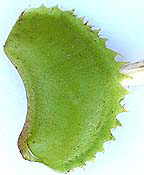
The bamboo skewer used to trigger the trap is barely visible on the right. For this to work the trap has to be freshly cut. If left to sit around it will wilt and become so limp it won't close.
Do traps close faster in bright sunlight?
No. I found one reference that claimed that in bright sunlight they closed in as little as 1/30 second. I placed my Fly Trap in bright sunlight for two hours and then sprung one of its traps. It eased closed in the usual 1/2 second. What I also found was temperature plays a big part in trap closure speeds. At 95-degrees they snap shut very fast. However, the plants are not 100-percent consistent on this. One trap on a plant will snap shut fast while another will close more slowly. Plant condition may also play a role.
What is the best artificial food to feed the traps?
I've tried Hikari Betta Bio-Gold fish food pellets and found the plants digest almost all of them. All that was left was a very small dark grain, much less residue than from a fly. Because the pellets are hard when dry, I soaked them in water a few hours to rehydrate them. I don't know if this makes a difference.
Freeze dried tubiflex worms have turned out to be the easiest to use so far. They come in 1/4-inch dry foamy cubes that can be cut with a razor blade into any convenient size and shape. I have three plants feeding on this right now and it'll be interesting to see how thoroughly they are digested. (Initial results aren't promising. Half of the traps fed tubiflex worms died. The others are still closed after more than a month.)
One interesting area of exploration is that using a dry food that can soak up water before being fed to a plant is that instead of just water it could be made to absorb water to which vitamins, fertilizers, and perhaps even growth hormones have been added. This might provide a method of force feeding fly traps a controlled diet that causes them to grow the largest traps.
After several months of experimenting with artificial foods I found that more often than not the trap dies before the food is digested. I'm going back to flies for feeding them.
Fly catching turned out to be a pain so I tried the Beta Biogold pellets again, this time using distilled water to hydrate them and only one out of 11 traps died. So I'm switching back to the pellets. Update: I tried this on a B-52 cultivar and it died after the edges of the traps turned black and whithered. I don't know if this was caused by bio-gold of some other problem so proceed with caution.
Catch flies easier!
My usual technique to catch flies to feed to my plants is to go out in the morning or evening to a south-facing wall on my house and trap flies soaking up the last warmth of the day. I'd try to place a plastic container over them before they flew away then slip a cover between the wall and the container. I had a 50-percent success rate. Then one day I was in Toys-R-Us and found the following Bug Vacuum gun:
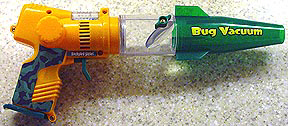
I found as long as the batteries were fresh it created enough suction to easily catch flies if the tip was brought within an inch or so of them. It makes my fly-catching expeditions much easier and quicker.
NEW!!! As of 2015, many professionals are reporting the highest growth rates using freeze dried bloodworms, which are available in many tropical fish stores. I've used them myself and found that the plants accept them very well, though they seem to take a long time to digest. The following video shows how to prepare and feed freeze dried bloodworms to Venus flytraps:
If you need to feed a very small Venus fly trap, the following video mat be helpful:
NEW!!! The following short video shows how an apparently dead fly trap may be resurrected with a little luck:
NEW!!! The following short video shows how to get rid of fungus gnats:
When feeding a fly trap dead food, how many times does the trap need to be pressed to trigger the second tightening/sealing closure?
I found that 30 pressings is enough whereas traps given 10 pressings seal only 10-percent of the time. This suggests that somewhere around 20 pressings is the minimum. I use 40 just to be sure.
How much torque can a closing trap generate?
I made a scale from a rubber band and after calibrating it, used it to measure the closing torque of a trap on a Big Mouth Venus Flytrap. The torque was 3.5 inch-ounces. Scaling this up from the trap's 0.5-gram weight to the 20-pound weight of a weight lifter's arm with an elbow-to-palm length of 14-inches means that he would be able to do biceps curls with a 300-pound bar.
How frost tolerant are Venus Fly Traps?
During the Fall of 2005 I observed a plant growing outside. It seemed to handle temperatures down to 28 degrees without damage. At 25 degrees the traps and leaves began showing distress. They turned slightly darker and looked as if they were turning translucent, like something soaked in water too long. At 22 degrees and below the leaves died and turned black. Note: my location in the high desert is very arid and clear. Such conditions can cause plants to radiate heat and actually get down to a lower temperature than the air. Plants in a humid, overcast location may be able to survive lower temperatures than mine did. Also not: although the plant leaves died back that does not mean that the plant itself is dead. It may have gone dormant and could sprout new leaves in Spring.
Does the number of traps on one plant being feed at once effect the speed at which the insects are digested?
One preliminary experiment suggests that the more traps that are feeding at one time the slower digestion will be. I fed a plant a fly and it was digested in four days. Then I fed three traps at the same time on the same plant and it took two weeks for the traps to begin reopening.
However, there are two factors that could have influenced the result. First, having just been fed one fly the plant may not have been hungry and as such not been in as much of a hurry to digest the next meal. Second, because there was some variation in insect size it could be that this slowed digestion.
I plan to pursue this issue with future experiments using artificial foods because they are more consistent in size.
How can the total energy collected by a Venus Flytrap from the sun for a typical day be measured and used to determine the power and duration of artificial lighting required to equal it?
I researched artificial light for my page on this subject (FLUORESCENT PLANT LIGHTING) and decided that because the frequency response of all but a few specialized and very expensive light meters is so much different than that of plants, that a mechanical approach to answering this question isn't the best way to go. A much better method is to simply grow plants under the best artificial lighting available and compare their growth to similar plants grown in fun sun. The biggest problem will be in making all the other factors that influence growth (amount of water, amount of food, temperatures, etc) as close as possible so that they don't influence growth rates.
What's the best soil in which to grow fly traps?
I've only tried two soil mixtures so far but already found they can effect at least the care of the plants if not their growth rates. The first mixture is 75 percent peat moss and 25 percent vermiculite. It compacted down to a solid mass and I've learned that this tighter medium is much better at pulling water up from water in the tray in which that planter sits than the second mixture, which was a 50 - 50 mix. The reason is that the 50 - 50 mix has so much vermiculite in it that it doesn't compact down and the open pores prevent the wicking action that draws water up through the medium. The mostly peat moss mix can easily pull water up three inches above the level of the water. The 50 - 50 mix can barely pull it up half that. This is important if deep planters are used because the water may not be able to reach the surface roots.
UPDATE!!! As of 2015 I only use the prepared Venus flytrap soil sold by FlytrapStore.com, which is peat moss, perlite and pure silica sand. Bottom watering until the soil is thoroughly saturated once every two weeks in summer (under artificial lighting) and once every six weeks in winter works well.
How do plants grown outside compare to those grown inside under fluorescent lamps?
Preliminary results suggest that my artificial lighting system grows plants at about the same rate that they grow outside against an east-facing wall that limits their exposure to morning sun only. The outside growth rate for plants against a south-facing wall painted white is twice what it is under my fluorescent system, but these plants tend to sustain considerable sunburn.
What does a super close-up photograph of a trigger hair look like?
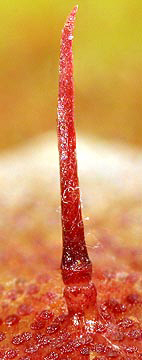
The most interesting feature of this image is that the ball joint near the hair's base is similar to the ball joint connecting a spider's leg to its body. The surface of the inside of the trap is covered with tiny polyps barely 0.001-inch in diameter. Magnified 1000 times they look like mushroom cap shaped raspberries.

I've photographed these polyps from many angles and they do not appear to be connected to the leaf by a stem. Rather, they seem to sit directly on the leaf's surface.
How many times can one trap be fed?
Most references claim that after four feeds the typical trap will die.
How does the trap size on the three varieties generally recognized as having spectacularly large traps (Big Mouth, Big Vigorous, Fang) compare?
They are all about the same: 1 and 1/4-inches long. Big Mouth traps look a little larger because of their shape.
What happens if a fly trap is planted outside in normal soil?
I tried this and it shriveled up, turned black and died in 10 days.
Can Venus Fly Traps thrive in low humidity conditions?
I have two outside that seem to be doing great in humidity that's typically less than 20 percent.
What do the different flowering phases look like?
My first Venus Fly Trap, Chomper - the one from Walmart, started growing a flower stalk in January. After two weeks of growth the stalk was 1-inch high and already topped with flower buds. (This image will appear actual-size on monitors set to 72 ppi.)
![]()
The flowers opened on 5 March.
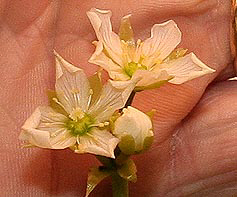
After a couple of months I collected several small black seeds, which I planted. Unfortunately none of them germinated.
If a fly trap is grown inside and it isn't feed and can't catch insects, will it still grow?
Yes, but extremely slowly. Fly trap roots can not take up nutrients very fast and most bog soils in which they grow are very poor. But, as organic mater breaks down there are enough of the nutrients they require to sustain slow growth. Catching insects or feeding them artificial food enables them to grow ten times faster, but even without these assists they will still make some growth.
Links:
NEW!!! In 2015 I rebuilt my fly trap collection by purchasing plants from three of the top on-line sources: carnivorousplantnursery.com, flytrapcare.com and flytrapranch.com. By far I received the largest, healthiest plants at the best price from the Flytrap Ranch.
http://www.connerscarnivores.com (Carries the B52 cultivar as well as the intimidating Fused Tooth, the unique Cupped Cap and many others rare types.)
http://www.carnivorousplantnursery.com (The widest variety of the best plants. This site also has extensive information about plants and their culture. This is where I purchased all my premium Venus Fly Traps.)
http://bestcarnivorousplants.com/dionaea (large selection of plants for sale)
http://dionea.homestead.com (great pictures and descriptions of all the cultivars)
http://www.strato.net/~cruny/sa03005.html
http://www.sarracenia.com/faq/faq2000.html (long list of questions and answers)
http://www.humbolt.edu/~rrz7001/Dionaea.html#Red_Priranha (Hundreds of Venus Fly Trap pictures)
Return to my main site for more gardening pages or browse over 90 other topics: everything from electric rocket engines to Knitting Nancys.